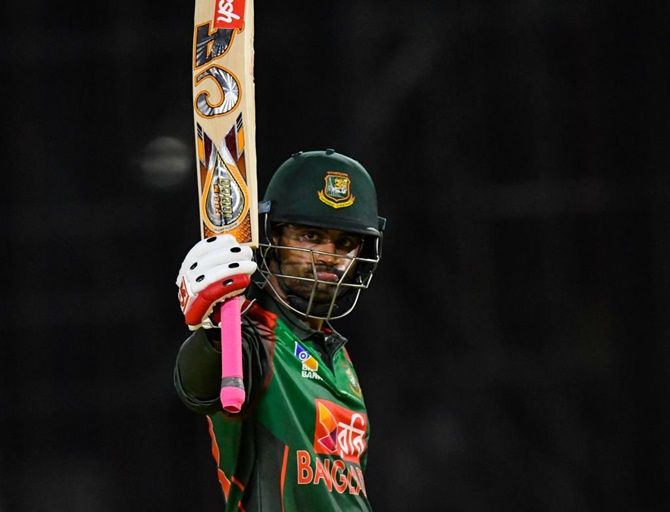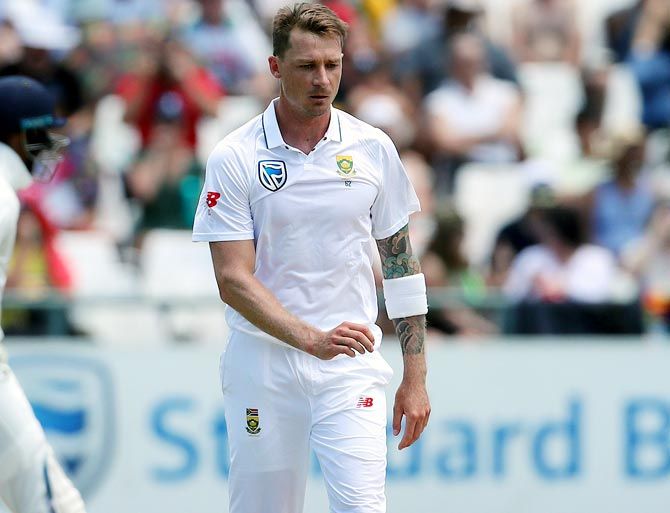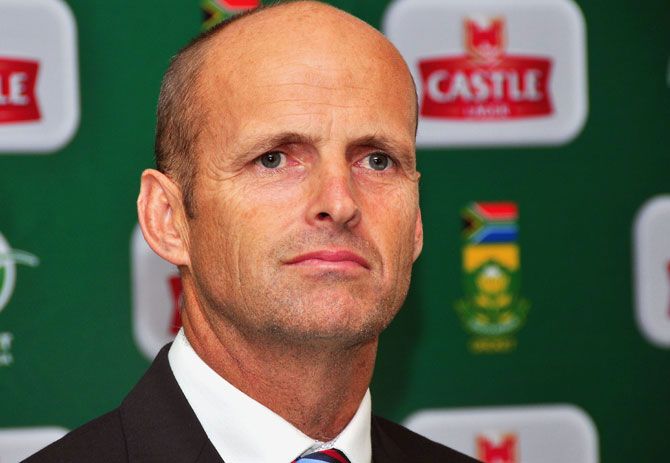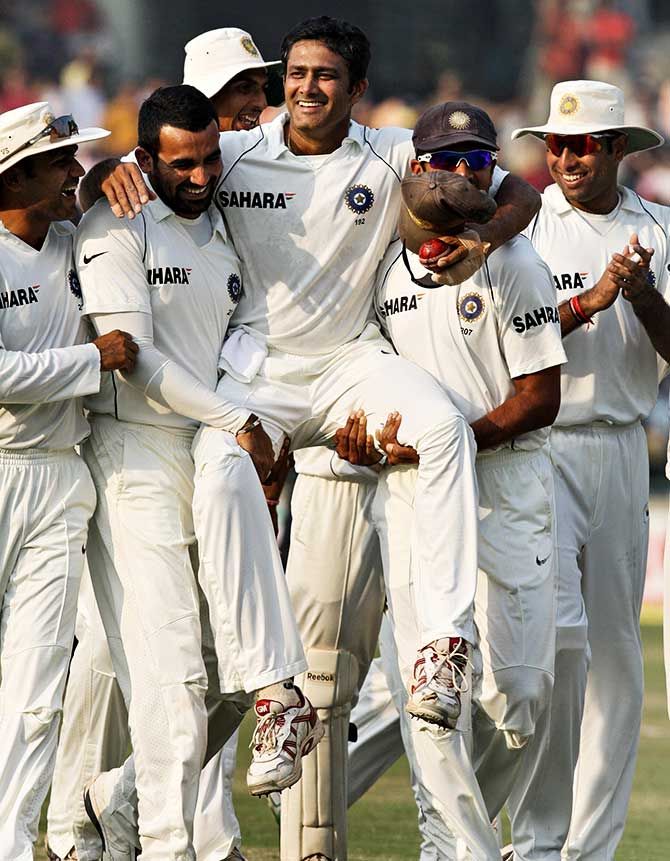Rajneesh Gupta salutes Tamim Iqbal's courage in the Asia Cup's opening game on Saturday and lists instances where cricketers braved injuries to battle it out for their teams.

Just two overs into the first game of the Asia Cup, the tournament was all but over for Bangladesh's opening batsman Tamim Iqbal who was hit on the wrist by a Suranga Lakmal delivery.
Tamim left the ground in pain and scans revealed a fracture which officially ruled him out of the tournament.
But Tamim was not done yet.
With Bangladesh reduced to 229/9 in the 47th over, Tamim walked into bat and give centurian Mushfiqur Rahim support despite being injured.
Tamim played a crucial role in Bangladesh extending the score beyond 260.
Even though Tamim played only one ball, more importantly he was at the other end as Mushfiqur hit the ball all over the park.
Rajneesh Gupta lists similar instances where cricketers braved injuries to battle it out for their teams.
Dale Steyn. South Africa vs India, Capte Town, 2018

One of the most memorable moments of the first India-South Africa Test was an injured Dale Steyn limping out to bat during his team's second innings despite being ruled out of the series.
Steyn had injured himself on the second day of the game when he landed awkwardly after delivering a ball.
He was told he would have to use crutches for the next few days to avoid putting any pressure on his injured left heel.
But he refused to stay in the dugout when the Proteas found themselves in a spot of bother at 130/9 in the second innings.
Steyn drew massive applause from the spectators for each of his blocks during the five-minute unbeaten stay at the crease which ended when A B de Villiers' all-important wicket became the last to fall for the hosts.
Skipper Faf du Plessis later said Steyn had padded up to bat even before the matter could be discussed with him.
Graeme Smith. South Africa vs Australia, Sydney, 2009

The series matched the 2005 Ashes for sheer drama.
In the first Test, South Africa pulled off a massive 414 run chase, and Dale Steyn's allround show in the second Test gave South Africa the series win.
The third Test may have been a dead rubber, but it held great significance for both teams.
Had South Africa achieved a clean sweep it would have become the number one side.
But it was not just the ranking that was at stake.
Australia posted 445 in the first innings.
Graeme Smith was batting on 30, at a run a ball.
Then Mitchell Johnson caused a ball to spit up and smash the South African captain's knuckle.
Smith retired hurt. South Africa were dismissed for 327.
Australia declared their second innings at 257/4, leaving South Africa to score 376 to win.
South Africa had already registered a remarkable chase in the series, but it was a different surface and the man who made it possible was watching the game in his green tracksuit.
He didn't even bring his whites to the ground.
South Africa slipped to 91/3.
The Australians kept striking regular blows as the visitors were reduced to 202/8.
Dale Steyn and Mkhaya Ntini then hung around for more than an hour.
Steyn was finally trapped lbw.
Just when Australia thought they had won the match, the South African skipper walked out at number 11 with borrowed clothes (The shirt came from Jacques Kallis, the sweater from Chris Harris), sans bandage or plaster. The crowd stood and roared.
With 8.2 overs to go, Smith lasted 26 minutes, wincing with pain and releasing his left hand when the ball jarred his bat.
Australian anxieties rose when Matthew Hayden dropped Ntini in the dying stages of the match.
Just 10 balls remained when Johnson shattered Smith's stumps with a vicious inswinger.
Stuart Broad. England vs India, Old Trafford, 2014

Stuart Broad retired hurt after being struck on the nose by a bouncer from Varun Aaron on the third day of the fourth Test.
Broad had just hooked a couple of Aaron bouncers for sixes, but trying to make it three in a row, he failed to connect with the ball lodging between the peak of his helmet and the grille.
As a result, Broad couldn't take part in the second innings.
He was back for the next Test at Lord's.
Wearing a mask to protect his nose, Broad picked up three wickets in a game that England won.
He put his fears behind and batted too, scoring 37 off 21 with 5 fours and a six.
Gary Kirsten. Pakistan vs South Africa, Lahore, 2003

Gary Kirsten was batting solidly on the first morning of the Test series, when Shoaib Akhtar produced a brute of A bouncer from around the wicket.
Kirsten tried to hook it, missed the ball completely, the ball sneaked in through the visor of his helmet and hit him just below the left eye. v
Bleeding profusely from a deep cut, Gary was taken to hospital.
He had 10 stitches and also sustained a broken nose.
He did not bat again in the innings as South Africa were bowled out for 320.
Pakistan responded with 401, putting South Africa under pressure.
South Africa were precariously placed at 149/4 in the second innings as Kirsten came out to bat, his face bruised from the blow.
He showed tremendous grit and scored 46 in almost two hours, before South Africa were bowled out for 241.
Pakistan went on to win the game by 8 wickets.
Anil Kumble. India vs the West Indies, Antigua, 2002

Anil Kumble was hit on the mouth by a menacing Mervyn Dillon bouncer.
Kumble spat out blood, but batted on for another 20 minutes before getting out to Dillon.
After the innings he was taken to hospital where it was found that he had broken his jaw.
He was due to fly back to Bangalore the next day for surgery.
Instead he came out to bowl with his face bandaged against doctors' advice. Kumble bowled 14 consecutive overs and got the prized scalp of Brian Lara.
Arjuna Ranatunga. Sri Lanka vs Pakistan, Rawalpindi, 2000

In the first Test of the series, Sri Lanka dismissed Pakistan for 182 and made 353.
Pakistan made amends in the second innings by scoring 390, leaving Sri Lanka with a target of 220.
Sri Lanka lost half their side with 144 runs on the board.
A snorter from Waqar Younis ensured that Arjuna Ranatunga retired hurt with a painful hand, leaving Sri Lanka more than 70 runs short with the tail exposed.
With 8 wickets down and 43 runs to get, Ranatunga came out to bat again.
Using just one hand at times, Ranatunga -- with Romesh Kaluwitharana -- secured a memorable 2 wicket win for Sri Lanka.
Malcolm Marshall. England vs the West Indies, Headingley, 1984
On the first day of the Test Malcolm Marshall broke his thumb in two places while fielding in the gully.
He was told he would not be able to play for another 10 days.
The West Indies bowled England out for 270 the next day, but the bowlers brought England back in the game by reducing West Indies to 206/7.
Larry Gomes and Michael Holding added 80 runs to give the West Indies the lead. With Gomes nearing his hundred, Holding got out. Joel Garner followed soon leaving Gomes stranded on 96.
Everyone thought the innings was over, but in walked Marshall.
He couldn't hold the bat with his top hand, but hung around for 16 minutes facing 8 balls batting with just one hand! That was all Gomes needed to reach his hundred.
That was not all.
Marshall then took 7 wickets for 53 in England's second innings as the hosts were dismissed for 159.
The West Indies reached the target without much fuss.
Rick McCosker. Australia vs England, MCG, 1977

Rick McCosker had his jaw broken by a bouncer from Bob Willis in the first innings of the Centenary Test.
McCosker remained in hospital for a day-and-a-half.
Australia were bowled out for 138, but routed England for a paltry 95.
Australia faced some early hiccups in the second innings, but wicket-keeper Rodney Marsh soothed the nerves with his splendid innings and useful partnerships with the lower order.
When the 8th wicket fell, Australia's score was 353. They were not out of the woods and hence McCosker came out to bat.
Batting with a wired jaw, McCosker stayed for 85 minutes and scored 25 runs.
Australia finally declared at 419/9.
Derek Randall's magnificent innings of 174 put England on the route to a remarkable win.
He was 5th out at 346 and England still had batsmen who could win the game, but Dennis Lillee tore through the tail to help Australia pull off a 45-run win.
Without McCosker's gutsy knock, the victory might not have been possible.
Colin Cowdrey. England vs the West Indies, Lord's, 1963

The Lord's Test of 1963 between England and the West Indies will go down in cricket history as one of the most thrilling Test matches of all time.
All four results were possible when the the final over of the game began.
The match finally ended in a draw, but not without some drama.
The West Indies made 301 in the first innings. England replied with 297.
The West Indies were bowled out for 229 in the second innings.
Chasing 234, England lost three wickets in quick time.
Colin Cowdey then took the score to 72 with Ken Barrington.
With the match in the balance, a Wes Hall delivery hit Cowdrey on the arm producing a sickening sound.
Cowdrey's arm was broken, and he would be unable to continue.
Barrington and Brian Close then played out of their skins, scoring terrific half-centuries to take England nearer and nearer.
A late fightback from the West Indies pacers saw England suddenly lose a bout of wickets.
It finally came down to a scenario in which England needed 8 to win off the final over with 2 wickets in hand.
With 6 to win off three balls, Derek Shackleton was run out.
Out walked Cowdrey, arm in plaster.
With 6 needed off 2 balls and one wicket in hand, David Allen blocked the last two deliveries to secure one of the most memorable draws in Test cricket.











